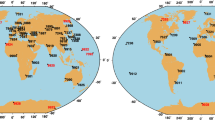Abstract
China’s Lunar Exploration Program (CLEP) prompted the design and construction of the globally distributed Chinese Deep Space Network (CDSN). This network consists of Jiamusi and Kashi stations in China, and Zapala station in Argentina. However, the positions of Jiamusi and Kashi are not accurate enough for future Chinese deep space missions, and geodetic Very Long Baseline Interferometry (VLBI) is the most effective way to determine their positions. Since the CDSN stations are equipped with narrow-band receivers, they cannot participate in current international VLBI sessions in which wide-band frequencies are utilized. Thus a cooperative geodetic program of the CDSN and Chinese VLBI Network (CVN, the VLBI tracking subsystem of the CLEP) was initiated to determine their positions, in which specially designed frequencies can be utilized, and some CVN stations can act as position reference stations owing to their precise positions from long-term international VLBI observations. Primary results have been obtained from the CDSN–CVN combined domestic VLBI experiments from September 28, 2014, through December 10, 2015. The positions of Jiamusi and Kashi are determined to be better than 10-mm precision in the X, Y, and Z directions, which are improved by a factor of approximately 20 over their a priori values.
摘要
在探月工程的带动下, 我国设计并建设了全球布局的中国深空网, 包括国内的佳木斯和喀什深空站, 以及位于阿根廷的萨帕拉深空站。 然而, 佳木斯和喀什深空站的站址精度无法满足我国未来深空探测任务的需求, 而测地 VLBI (甚长基线干涉测量) 方法是最有效的站址标定方法。 由于中国深空站配置的是窄带接收机, 无法参加目前国际 VLBI 的宽带观测, 因此只能寻求与中国 VLBI 网 (我国探月工程的测轨分系统) 开展联合观测实现站址标定, 这样可以协商采用专门的观测频率, 且中国 VLBI 网的部分台站经过长期参加国际 VLBI 联测, 已经具备极高精度的站址, 可以作为站址标定的参考站。 通过处理 2014 年 9 月 28 日至 2015 年 12 月 10 日开展的中国深空网—中国 VLBI 网联合观测的数据, 我们解算得到了佳木斯和喀什深空站的站址, 二者的 X、 Y、 Z 分量的精度均优于 10mm, 相对于站址初标精度提高了大约 20 倍。
创新点
-
1、
采用兼容频率设置开展窄带—宽带 VLBI 联合观测, 既保证了数据的兼容性, 又充分发挥了宽带的优势
-
2、
利用速度场插值法获取了佳木斯、 喀什深空站的先验速度, 并约束其全局参数解
-
3、
首次得到了佳木斯和喀什深空站优于 10mm 形式精度的站址, 相对于站址初标精度提高了大约 20 倍
Similar content being viewed by others
References
Zhou H, Li H T, Dong G L. Relative position determination between Chang’E-3 lander and rover using in-beam phase referencing. Sci China Inf Sci, 2015, 58: 092201
Folkner W M. DSN Station Locations And Uncertainties. TDA Progress Report 42-128. 1996
Petrov L, Gordon D, Gipson J, et al. Precise geodesy with the very long baseline array. J Geod, 2009, 83: 859–876
Li J L, Xiong F W, Yu C L, et al. Precise determination of the reference point coordinates of Shanghai Tianma 65-m radio telescope. Chin Sci Bull, 2014, 59: 2558–2567
Lösler M. Reference point determination with a new mathematical model at the 20 m VLBI radio telescope in Wettzell. J Appl Geod, 2008, 2: 233–238
Lösler M. New mathematical model for reference point determination of an azimuth-elevation type radio telescope. J Surv Eng, 2009, 135: 131–135
Rogers A E E. Very long baseline interferometry with large effective bandwidth for phase-delay measurements. Radio Sci, 1970, 5: 1239–1247
Li J L, Guo L, Zhang B. The Chinese VLBI network and its astrometric role. In: Proceedings of the International Astronomical Union, Shanghai, 2007. 182–185
Gipson J. An introduction to sked. In: Proceedings of the 6th IVS General Meeting: VLBI2010: From Vision to Reality, Hobart, 2010. 77–84
Gorham P W. Designing Optimal Bandwidth Synthesis Arrays for VLBI. The Telecommunications and Mission Operations Progress Report 42-133. 1998
Wietfeldt Jr R D. A frequency-agile system for VLBI bandwidth synthesis. Dissertation for Ph.D. Degree. Toronto: York University, 1995. 12–14
Whitney A R. Precision geodesy and astrometry via very-long-baseline interferometry. Dissertation for Ph.D. Degree. Cambridge: Massachusetts Institute of Technology, 1974. 115–116
Deller A T, Tingay S J, Bailes M, et al. DiFX: a software correlator for very long baseline interferometry using multiprocessor computing environments. Publ Astron Soc Pac, 2007, 119: 318–336
Tingay S J, Alef W, Graham D, et al. Geodetic VLBI correlation in software. J Geod, 2009, 83: 1061–1069
Petit G, Luzum B. IERS Conventions (2010). IERS Technical Note No. 36. 2010
Niell A E. Global mapping functions for the atmosphere delay at radio wavelengths. J Geophys Res, 1996, 101: 3227–3246
Altamimi Z, Collilieux X, Métivier L. ITRF2008: an improved solution of the international terrestrial reference frame. J Geod, 2011, 85: 457–473
Fey A L, Gordon D, Jacobs C S, et al. The Second Realization of the International Celestial Reference Frame by Very Long Baseline Interferometry. IERS Technical Note No. 35. 2009
Wang G L, Ye S H, Qian Z H, et al. Measurements of the VLBI experiments during the first campaign of the Asian-Pacific space geodynamics (APSG) program. Sci China Ser A, 2001, 44: 259–264
Schlüter W, Behrend D. The international VLBI service for geodesy and astrometry (IVS): current capabilities and future prospects. J Geod, 2007, 81: 379–387
Author information
Authors and Affiliations
Corresponding author
Rights and permissions
About this article
Cite this article
Dong, G., Xu, D., Li, H. et al. Initial result of the Chinese Deep Space Stations’ coordinates from Chinese domestic VLBI experiments. Sci. China Inf. Sci. 60, 012203 (2017). https://doi.org/10.1007/s11432-016-0195-9
Received:
Accepted:
Published:
DOI: https://doi.org/10.1007/s11432-016-0195-9
Keywords
- VLBI
- Chinese Deep Space Network
- Chinese VLBI Network
- station position determination
- terrestrial reference frame




